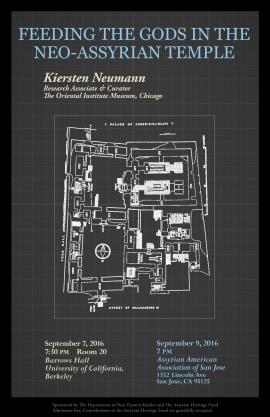Feeding the Gods in the Neo-Assyrian Temple
Kiersten Neumann
Research Associate & Curator
Oriental Institute Museum
February 8, 2017
7:30 PM
Room 60
Evans Hall
University of California, Berkeley
February 10, 2017
7:00 PM
Assyrian American Association of San Jose
1352 Lincoln Ave, San Jose, CA 95125
As communicated by Mesopotamian creation myths such as Enūma Eliš and Atra-ḫasī, the provisioning of the gods was the reason for which humans were originally created and, to quote the great Mesopotamian historian A. Leo Oppenheim, “the very raison d’être of the entire [temple] institution.” This provisioning—the presentation of offerings—incorporated a host of powerful sensory elements that together ritualized and marked this practice as unique and meaningful. The principal components of this practice were the food, drink, and aromatics served to the god. Offering tables, libation vessels, and incense burners made exotic woods, light-colored stone, and precious metals facilitated the preparation and presentation of these goods. Made from similar types of materials was the divine statue itself, which manifest the resident divinity of the temple. The complimentary materials and arrangement of these objects and the god within the temple would have had a strong visual impact on participants. Alongside the visual was the smell of aromatics from incense burners, oils from oil burners, and the aroma of food offerings; the sounds of lamentations and prayers being recited and songs performed; the tactile sensations of the offerings and portable works of art; and the gustatory experience of consuming leftover offerings. Additionally, the radiance of the statue and other materials communicated a sense of divinity and the otherwordly, while a sense of timing and movement was integral to the proper functioning of this performance. In this talk I will explore how this corpus of multisensory phenomena of the presentation of offerings to the gods marked this practice as something “other,” as ritualized practice fit for the dwelling place of a god within the cultural and social context of the Neo-Assyrian Empire.


